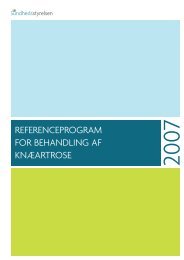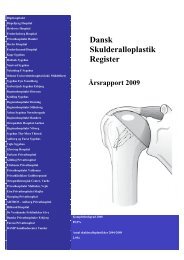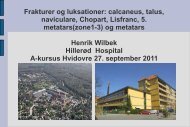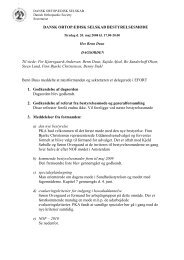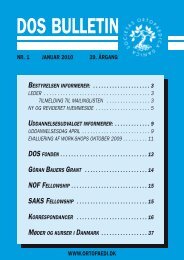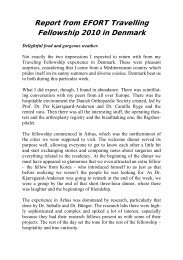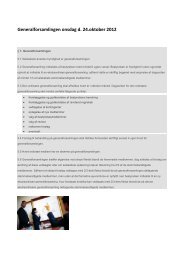DOS BULLETIN - Dansk Ortopædisk Selskab
DOS BULLETIN - Dansk Ortopædisk Selskab
DOS BULLETIN - Dansk Ortopædisk Selskab
You also want an ePaper? Increase the reach of your titles
YUMPU automatically turns print PDFs into web optimized ePapers that Google loves.
2010-378_<strong>DOS</strong> nr. 3 2010 29/09/10 10:08 Side 102<br />
Test-retest reliability of maximal leg muscle power<br />
and functional performance measures in patients with<br />
severe osteoarthritis (OA)<br />
Allan Villadsen, Søren Overgaard,<br />
Ewa Roos, Anders Holsgaard Larsen<br />
Institute of Sport Sciences and Clinical Biomechanics, University of<br />
Southern Denmark; Department of Orthopaedic Research,<br />
Institute of Clinical Research, University of Southern Denmark<br />
Background: Muscle power, taking both strength and velocity into account, is a<br />
more functional measure of lower extremity muscle activity compared with the<br />
traditionally used isometric and/or isokinetic muscle strength. More functional<br />
measures are preferred to determine muscle function and as outcomes in exercise<br />
studies in patients with OA.<br />
Purpose: To evaluate the reliability of single-joint and multi-joint maximal leg<br />
muscle power as well as functional performance measures in patients with severe<br />
OA.<br />
Methods: Subjects: 20 patients diagnosed with severe OA and scheduled for<br />
unilateral total hip or knee replacement (mean age: 68.7 ± 7.24). 11 knee patients<br />
(6 female) and 9 hip patients (4 female), volunteered to participate. Subjects<br />
underwent a test battery on two occasions separated by approximately one week<br />
(range 7 to 11 days). Muscle power was measured using a linear encoder during<br />
unilateral isolated single-joint knee extension and flexion and unilateral isolated<br />
single-joint hip extension and abduction. Muscle power of unilateral multi-joint<br />
knee and hip extension was obtained with a leg extension press. Three functional<br />
performance measures (20 m walk, 5 times chair stands, maximal number of<br />
knee bends/30sec) were also evaluated. Pain was measured on a VAS scale prior<br />
to and after conducting the entire test battery.<br />
Findings: For single-joint maximal peak power the observed CVws ranged from<br />
7-25% and for multi-joint maximal peak power from 20-22%. For the three functional<br />
performance measures (20 m walk, 5 times chair stands, maximal number<br />
of knee bends/30sec) the CVws were 5%, 14%, and 17%, respectively. A systematic<br />
and significant improvement was observed for the multi- joint maximal<br />
peak power (p=.0046, CI - 28.8;-6.13), 5 times chair stands (p=.004, CI<br />
0.96;2.66) and 20 m walk (p=.0037, CI 0.16;0.68) indicating a learning effect. A<br />
decrease in pain was found after testing (VAS change score) (p=.0005, CI -1,64;<br />
-.55).<br />
Conclusion: Familiarization sessions are needed to avoid learning effects when<br />
testing muscle function. Single-joint and multi- joint muscle power over the hip<br />
and knee, and functional performance measures, can be evaluated with moderate<br />
to good reliability in patients with severe OA. The test battery was feasible for<br />
elderly patients with severe OA as indicated by no increase in pain after testing.<br />
102




